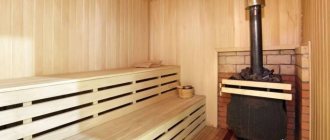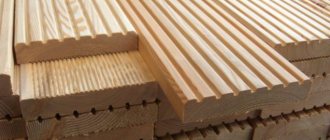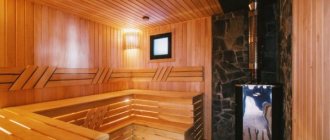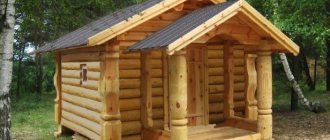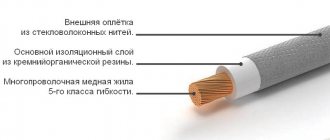About 20 years ago, a material appeared that was used to decorate not only facades, but also for the interior decoration of various buildings - this is a block house. Initially in demand in European countries and the USA, it soon became popular in Russia and neighboring countries. The finishing made with such panels creates an imitation of a wooden frame. In addition, the material is environmentally friendly and easy to install. Therefore, panels are now in demand when cladding baths. Covering the bathhouse with a block house on the outside will make the building beautiful, it will look in a classic style.
What is a block house
Block house is an environmentally friendly material. The panels are made from a whole block of wood, their surface is even and smooth, pleasant to the touch. At first glance it seems that these are logs. But unlike them, during further installation and operation the block house is reliable, the manufacturer guarantees quality. Due to the frequent and close arrangement of fibers, the material does not dry out or crack for a long period of time.
The appearance of the material imitates wood. Its outer part has rounded dimensions, similar to a log wall. Exhaust grooves are provided inside the panel, and tongue-and-groove locking joints are created on the long side ends, their purpose is to tightly and efficiently fasten the planks to each other.
The starting material for the production of a block house is wood, for example, larch, cedar, ash. All raw materials are pre-dried and coated with antiseptic agents. In addition to boards, the initial material used for manufacturing could have been metal or vinyl.
Valuable recommendations
Dear friends, in order for the finishing to delight you with its impeccability, you should:
- perform work in warm and dry seasons;
- handle each element extremely carefully;
- use dry bars of the correct geometry as lathing;
- treat the sheathing with antiseptics and fire retardants;
- Under no circumstances should you simply mount the block house on the wall;
- use products from trusted manufacturers.
Dear readers, remember! If you doubt your capabilities, do not experiment. Use the services of highly qualified specialists to avoid disastrous consequences.
Block house is a universal cladding material that gives absolutely any design bright notes of presentability and charm! Don’t hesitate, your bathhouse or home will definitely love such an elegant finish.
Natural magic to your structure. And I'll leave it at that. Bye!
Wisdom Quote: It is better to say too much than not to say what is necessary.
Types of block house and choice for a bathhouse
A bathhouse made from a block house is the best option; it combines aesthetics, practicality and budget cost. Proper processing of panels prevents shrinkage, deformation, cracking and rotting. High humidity and sudden temperature changes are not a problem for a block house; it is resistant to such conditions.
The material has a number of varieties. According to production technology, it is divided into acrylic, vinyl, metal and wooden types. For a bathhouse, of course, wood is best suited.
Block house panels made from natural boards require impregnation with a fire retardant and antiseptic agent once every five years.
There are four classes of wood varieties of material. They differ from each other in the quality of their class.
- Class “C” is the lowest; the panels contain unfinished knots or holes, small chips and cracks, and sometimes fragments of bark.
- Class “B” is processed more efficiently, but even here there are cracks and knots, darkening of the wood.
- Class “A” is planed well, there are no mechanical damages, sometimes only knots are found.
- Another class is “Extra”, the name speaks for itself, the surface of this material is perfectly processed. This block house is used only for interior decoration. Exterior finishing is made with lower quality material.
Before choosing a block house, you must check the material for moisture. Overdried or damp panels lose their strength and may become deformed.
When purchasing material, you should consider its type of purpose. For the steam room, experts advise choosing products made from linden, while the outside is best decorated with products made from aspen or coniferous trees.
Care tips and advice
Service life and appearance depend not only on the initial choice of building material and its correct installation, but also on subsequent care and careful treatment. Simple steps to care for the skin will protect it from external factors and deformation. After installing the panels, they are coated with a primer, then a wax-based varnish is applied.
During operation, you should periodically remove dust from the surface with a vacuum cleaner and carry out wet cleaning. It is recommended to renew the coating every five years. This procedure will not only increase the service life, but will also renew the appearance and shine of the panels.
Exterior decoration of a bathhouse with a block house
Practice shows that for facade finishing a panel is required, the minimum length of which is four meters, and the maximum length is six meters. The width of a block house for a bathhouse should be from 10 to 20 centimeters. For exterior work, you can choose panels of any quality class, it all depends on the budget. When calculating the amount of facing material, you should set aside some reserve; if there is not enough, you will have to get it from another batch, where differences in color and texture are possible.
Production
The production process consists of the following stages:
- logs are sawn according to the “Square in a circle” technology;
- the wood is dried in a special chamber (humidity up to 12%);
- dimensions are adjusted, grooves are cut, combs are made, grooves are created;
- the material is polished;
- raw materials are treated with antiseptic and antifungal compounds;
- product quality is checked;
- the goods are packaged.
Thus, a popular finishing material is born. Although some people prefer imitation timber. As they say: how many people - so many opinions...
Sheathing for block house
Preparation for lining the outside of the bathhouse with a block house
The material is prepared for work in several stages.
- The panels are first laid out on the street, near the building, always under a canopy. Wood fiber must adapt to external natural conditions;
- In order to prevent the ingress of moisture and protect against insects, it is required to be well treated with antiseptic preparations. This is done twice. After the first treatment, you should wait until it dries completely, then the roughness is smoothed out, and the second layer is applied;
- for external work, insulation, waterproofing material and a film providing protection from the wind are prepared in advance.
Which material is better for a bathhouse: linden or aspen?
Both lumber have their pros and cons. If you choose between these two lumbers, then of course linden. Such lumber has higher strength characteristics and better withstands exposure to high temperatures and moisture. As for aspen, it is better not to use it for lining the inside of a bathhouse.
Firstly, the material is afraid of moisture and hot air, and secondly, if damage in the form of chips or scratches appears on such a lining, then a rotten area will form in this place.
Instructions for finishing a bathhouse with a block house outside
The process of lining the outside of the bathhouse is carried out in a certain order.
- We attach a sheathing made of 3×5 centimeter timber, slats and a corner to the wall of the building. We fix it with self-tapping screws. We install the frame parts in increments of approximately 70 centimeters;
- fill the voids between the slats with insulation, its layer should be five centimeters;
- We place wind and waterproofing. We fasten the material with an overlap, glue it along the seam, and fix it to the insulation with staples;
- We create an internal ventilated space. To do this, we add a sheathing with thin slats to the main structure and fix it again with self-tapping screws;
- We fasten it in a horizontal position, with the connection of the structure at the top. Self-tapping screws will come in handy again;
- Using a drill, we drill holes in increments of 60 centimeters. We fix the panel twice, at the tenon and at the groove;
- We treat the skin with an antiseptic, then after it dries we prime and varnish. The final touch is the installation of platbands.
Application
Most often, blockhouses are used for finishing dachas, summer houses, gazebos, verandas, baths, saunas, and frame houses. Gazebos made from blockhouses are very popular for gardens and summer cottages. They are easy to install and look very nice.
A gazebo from a blockhouse is a beautiful view. Blockhouses are increasingly being used for the exterior and interior decoration of bathhouses.
If you decide to build a sauna with your own hands, then the best option is a frame sauna. Its advantages are obvious:
- easy and quick to build - a frame is erected from timber, covered with wood boards with insulation;
- economically beneficial - these “sandwiches” will cost you much less than a wooden or brick bathhouse.
Features of finishing a bathhouse inside a block house
The process of finishing the walls of the bathhouse begins with the preparation of bars for the sheathing, the thickness of which is equal to the layer of thermal insulation. They must first be treated with an antiseptic drug. The work is carried out in several stages.
First, waterproofing work is carried out. Then the outermost bars of the sheathing are mounted, using a fishing line to check the evenness of the wall. The next stage is laying insulation.
If the bathhouse has a stove that is heated with wood, then we insulate the area near the chimney with basalt wool. After which a waterproofing and vapor barrier layer is laid overlapping. All joints are fixed with tape. Next is the sheathing again, using bars with a cross-sectional area of five square centimeters. The panels are fastened with the tenon facing up, the screws are screwed in at an acute angle. The final stage of the interior design of the bathhouse is lining the ceiling.
Internal lining of the bath room
For interior decoration of the bath room, boards 80-90 mm wide are used. Putty is used to mask the holes. To prevent moisture accumulation in the grooves, the tenon should be directed upward. To correctly install the corners, you should cut the boards at an angle of 45 degrees or use them to mount the slats.
Decoration of a bath room Source alyansles.ru
The interior lining of the bathhouse should be done after the building has settled. Wall cladding must be carried out after laying the floor covering. Installing a vapor barrier helps protect natural materials from rotting. Then the insulation is attached to the vapor barrier and the sheathing is installed. The bars for the sheathing must be treated with an antiseptic composition, the pitch of the bars for the sheathing must be 50 cm. Then it is necessary to cover the wall with a waterproofing layer.





